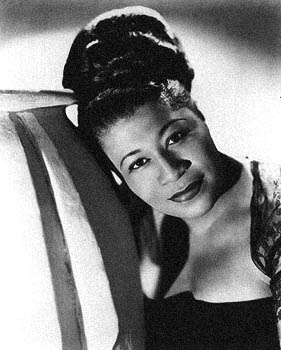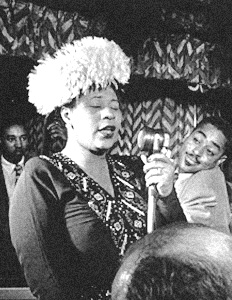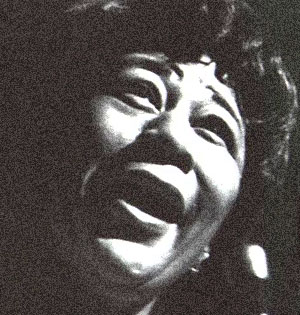
Ella Fitzgerald
- Подробности
 Ella Jane Fitzgerald (April 25, 1917 – June 15, 1996), also known as Lady Ella and the First Lady of Song, is widely considered the most influential jazz vocalist of the 20th Century.
Ella Jane Fitzgerald (April 25, 1917 – June 15, 1996), also known as Lady Ella and the First Lady of Song, is widely considered the most influential jazz vocalist of the 20th Century.
Fitzgerald was a groundbreaking performer who broke the color barrier at numerous venues across the United States before and during the Civil Rights Movement. She was the first African American female singer to achieve widespread commercial success with white audiences.
With a vocal range spanning three octaves, she was noted for her purity of tone, faultless phrasing and intonation, and a "horn-like" improvisational ability, particularly in her scat singing. Along with Frank Sinatra, whom she significantly influenced, she is considered to have been the supreme interpreter of the Great American Songbook.
Over a recording career that lasted fifty-seven years, she was the winner of thirteen Grammy Awards, and was awarded the National Medal of Art by Ronald Reagan and the Presidential Medal of Freedom by George H. W. Bush.
Biography
Early life
She was born Ella Jane Fitzgerald in Newport News, Virginia, on April 25, 1917, the child of a common-law marriage between William and Temperance “Tempie” Fitzgerald. The pair separated soon after Ella's birth and she and her mother moved to Yonkers, New York, with Tempie's boyfriend, Joseph Da Silva. Ella's half-sister, Frances Da Silva, was born in 1923.
In her youth, Ella wanted to be a dancer, though she loved listening to jazz recordings of Louis Armstrong, Bing Crosby and The Boswell Sisters. She idolized the lead singer of the Boswell Sisters, Connee Boswell, later saying, "My mother brought home one of her records, and I fell in love with it....I tried so hard to sound just like her."
In 1932, Ella's mother died from a heart attack. After staying with Da Silva for a short time, Ella was taken in by Tempie's sister, Virginia. Shortly afterward, Da Silva suffered a heart attack and died, and her sister Frances joined Ella in Virginia.
Following these traumatic events, Ella's academic grades dropped dramatically, and she frequently skipped school. At one point, she worked as a lookout at a bordello and also with a Mafia-affiliated numbers runner. After getting into trouble with the police, she was taken into custody and sent to a reform school. Eventually Ella escaped from the reformatory, and for a time was homeless.
She made her singing debut at seventeen on November 21, 1934 at the Apollo Theater in Harlem, New York. Ella's name pulled in a weekly audience at the Apollo and she won the opportunity to compete in one of the earliest of its famous "Amateur Nights." She had originally intended to go on stage and dance, but intimidated by the Edwards Sisters, a local dance duo, she opted to sing instead, in the style of Connie Boswell. She sang Hoagy Carmichael's "Judy" and "The Object of My Affection", a song recorded by the Boswell Sisters, and won the first prize of US$25.00.
Big-band singing
In January 1935 she won the chance to perform for a week with the Tiny Bradshaw band at the Harlem Opera House. Ella met drummer and bandleader Chick Webb here for the first time. Webb had already hired male singer Charlie Linton to work with the band, and was, The New York Times later wrote, "reluctant to sign her....because she was gawky and unkempt, a diamond in the rough." Webb offered Ella the opportunity to test with his band when they played a dance at Yale University. Despite the rough crowd, Ella was a great success, and Webb hired her to travel with the band for US$12.50 a week.
She began swinging regularly with Webb's Orchestra through 1935, at Harlem's Savoy Ballroom. Fitzgerald recorded several hit songs with them, including "Love and Kisses" and "(If You Can't Sing It) You'll Have to Swing It (Mr. Paganini)" but it was her 1938 version of the nursery rhyme, "A-Tisket, A-Tasket", a song she co-wrote, that brought her wide public acclaim.
Chick Webb died on June 16, 1939, and his band was renamed "Ella Fitzgerald and her Famous Orchestra" with Ella taking the role of bandleader. Ella recorded nearly 150 sides during her time with the orchestra, most of which, like "A-Tisket, A-Tasket", were "novelties and disposable pop fluff."
The Decca years
In 1942, Fitzgerald left the band to begin a solo career. Now signed to the Decca label, she had several popular hits, while recording with such artists as the Ink Spots, Louis Jordan, and the Delta Rhythm Boys.
With Decca's Milt Gabler as her manager, she began working regularly for the jazz impresario Norman Granz, and appearing regularly in his Jazz at the Philharmonic concerts. Fitzgerald's relationship with Granz was further cemented when he became her manager, although it would be nearly a decade before he could record her on one of his many record labels.
With the demise of the Swing era, and the decline of the great touring big bands, a major change in jazz music occurred in this period. The advent of bebop caused a major change in Fitzgerald's vocal style, influenced by her work with Dizzy Gillespie's big band. It was in this period that Fitzgerald started including scat singing as a major part of her performance repertoire. While singing with Gillespie, Fitzgerald recalled, "I just tried to do what I heard the horns in the band doing."
Her 1945 scat recording of "Flying Home" would later be described by The New York Times as "one of the most influential vocal jazz records of the decade....Where other singers, most notably Louis Armstrong, had tried similar improvisation, no one before Miss Fitzgerald employed the technique with such dazzling inventiveness." Her be-bop recordings of "Oh, Lady be Good!" (in 1947) and "How High the Moon" were similarly popular, and increased her reputation as one of the leading jazz vocalists.
Perhaps responding to criticism, and under pressure from Granz (who felt that Fitzgerald was given unsuitable material to record during this period), her last years on the Decca label saw Fitzgerald recording a series of duets with pianist Ellis Larkins, released in 1950 as Ella Swings Gershwin.
Move to Verve and mainstream success
Still performing at Granz's JATP concerts, by 1955, Fitzgerald left the Decca label, and Granz, now her manager, created the jazz record company Verve around her.
Fitzgerald later described the period as strategically crucial, saying, "I had gotten to the point where I was only singing be-bop. I thought be-bop was 'it', and that all I had to do was go some place and sing bop. But it finally got to the point where I had no place to sing. I realized then that there was more to music than bop. Norman....felt that I should do other things, so he produced The Cole Porter Songbook with me. It was a turning point in my life."
Ella Fitzgerald Sings the Cole Porter Songbook, released in 1956, was the first of eight "Songbooks" Fitzgerald would record for Verve at irregular intervals from 1956 to 1964. The composers and lyricists spotlighted on each album, taken together, represent the greatest part of the cultural canon known as the Great American Songbook. Fitzgerald's song selections ranged from well-known standards to little-heard rarities, and represented an attempt by Fitzgerald to cross over into a non-jazz audience.
Ella Fitzgerald Sings the Duke Ellington Songbook was the only Songbook on which the composer she interpreted played with her, Ellington and his longtime collaborator Billy Strayhorn wrote two new pieces of music for the album, "The E and D Blues" and he composed a four movement musical portrait of Fitzgerald.
The Songbook series ended up becoming the singer's most critically acclaimed and commercially successful work, and probably her most significant offering to American culture. The New York Times wrote in 1996, "These albums were among the first pop records to devote such serious attention to individual songwriters, and they were instrumental in establishing the pop album as a vehicle for serious musical exploration."
A few days after Fitzgerald's death, The New York Times columnist Frank Rich wrote that, in the Songbook series, Fitzgerald "performed a cultural transaction as extraordinary as Elvis's contemporaneous integration of white and African-American soul. Here was a black woman popularizing urban songs often written by immigrant Jews to a national audience of predominantly white Christians." Frank Sinatra was moved out of respect for Fitzgerald to block Capitol from re-releasing his own recordings in a similar, single composer vein.
Ella Fitzgerald also recorded albums exclusively devoted to the songs of Porter and Gershwin in 1972 and 1983, the albums being Ella Loves Cole and Nice Work If You Can Get It, respectively. A later collection devoted to a single composer was released during her time with Pablo Records, Ella Abraca Jobim, featuring the songs of Antonio Carlos Jobim.
While recording the 'Songbooks' and the occasional studio album, Ella toured 40 to 45 weeks per year in the United States and internationally, under the tutelage of Norman Granz. Granz helped solidify Ella's position as one of the leading live jazz performers.
The mid-1950s saw Ella become the first African-American to perform at the Mocambo, after Marilyn Monroe had lobbied the owner for the booking. The booking was instrumental in Fitzgerald's career. The incident was turned into a play by Bonnie Greer in 2005.
There are several live albums on Verve that are highly regarded by critics: Ella at the Opera House shows a typical JATP set from Ella, Ella in Rome is a verifiable 1950s jazz vocal masterclass, while Ella in Berlin is still one of Ella's biggest selling albums. 1964's Ella at Juan-Les-Pins and 1966's Ella and Duke at the Cote D'Azur both find a confident Ella accompanied by a stellar array of musicians.
Later years
Verve Records was sold to MGM in 1963, for US$3 million, and in 1967 MGM failed to renew Ella's contract with them. Over the next 5 years, she flitted between several labels, namely Atlantic, Capitol and Reprise. A selection of Ella's material at this time represent a curious departure away from her typical jazz repertoire; for Capitol she recorded Brighten the Corner, an album of Christian hymns, Ella Fitzgerald's Christmas, an album of traditional Christmas carols, Misty Blue, a country and western influenced album, and 30 by Ella, a series of six medleys that neatly fulfilled Ella's obligations for the label.
The surprise success of the 1972 album Jazz at Santa Monica Civic '72 led Norman Granz to found his first record label since the sale of Verve, Pablo Records. Ella recorded some 20 albums for the label. Her years on Pablo documented the decline in her voice; "She frequently used shorter, stabbing phrases," one biographer of Fitzgerald wrote, "and her voice was harder, with a wider vibrato". Plagued by health problems, Fitzgerald made her last recording in 1991 and her last public performances in 1993.
Personal life
Ella's almost constant touring and recording from the mid 1930s till the early 1990s made sustaining any relationship difficult.
Fitzgerald married twice, though there is evidence that she may have married a third time. In 1941 she married Benny Kornegay, a convicted drug dealer and hustler. The marriage was annulled after two years.
Fitzgerald married for the second time in December 1947 to the famous bass player Ray Brown, whom she had met while on tour with Dizzy Gillespie's band a year earlier. Together they adopted a child born to Fitzgerald's half-sister, Francis, whom they christened Ray Brown, Jr. With the singer often busy touring and recording, the child was largely raised by Ella's aunt, Virgina. Fitzgerald and Brown divorced in 1953, due to the various career pressures both were experiencing at the time, though they would continue to perform together.
In July 1957, Reuters reported that Fitzgerald had secretly married Thor Einar Larsen, a young Norwegian, in Oslo. She had even gone as far as furnishing an apartment in Oslo, but the affair was quickly forgotten when Larsen was sentenced to five months hard labour in Sweden for stealing money from a young woman to whom he had previously been engaged.
The singer was also notoriously shy. Trumpet player Mario Bauza, who played behind Ella in her early years with Chick Webb, remembered that "She didn’t hang out much. When she got into the band, she was dedicated to her music….She was a lonely girl around New York, just kept herself to herself, for the gig." When, later in her career, the Society of Singers named an award after her, Fitzgerald tellingly explained, "I don't want to say the wrong thing, which I always do. I think I do better when I sing."
Already blinded by the effects of diabetes, Fitzgerald had both her legs amputated in 1993. In 1996 she died of the disease in Beverly Hills, California, at the age of 79. She is interred in the Inglewood Park Cemetery in Inglewood, California. Several of Fitzgerald's awards, significant personal possessions and documents were donated to the Smithsonian Institution, the library of Boston University, the Library of Congress, and the Schoenberg Library at UCLA.
Film and television
In her most notable screen role, Fitzgerald played the part of singer Maggie Jackson in Jack Webb's 1955 jazz film Pete Kelly's Blues. The film costarred Janet Leigh and singer Peggy Lee. Despite the fact that Ella had already worked in the movies (she had sung briefly in the 1942 Abbott and Costello film Ride 'Em Cowboy), she was "delighted" when Norman Granz negotiated the role for her, and, "at the time....considered her role in the Warner Brothers movie the biggest thing ever to have happened to her." Amidst The New York Times's pan of the film when it opened in August 1955, the reviewer wrote, "About five minutes (out of ninety-five) suggest the picture this might have been. Take the ingenious prologue....Or take the fleeting scenes when the wonderful Ella Fitzgerald, allotted a few spoken lines, fills the screen and sound track with her strong mobile features and voice."
Similar to another African-American jazz singer, Lena Horne, Fitzgerald's face precluded major big-screen success. After Pete Kelly's Blues, the singer appeared in sporadic movie cameos, in St. Louis Blues (1958), and Let No Man Write My Epitaph (1960). Much later, she appeared in the 1980s television drama The White Shadow.
The singer also made numerous guest appearances on television shows, singing on the The Frank Sinatra Show, and alongside Nat King Cole, Dean Martin, Mel Torme and many others. Perhaps her most unusual and intriguing performance was of the 'Three Little Maids' song from Gilbert and Sullivan's comic operetta The Mikado alongside Dame Joan Sutherland and Dinah Shore on Shore's popular weekly variety series in 1963.
Fitzgerald also appeared in TV commercials, her most memorable being an ad for Memorex. In the commercials, she sang a note that shattered a glass while being recorded to a Memorex cassette tape. The tape was played back and the recording also broke the glass, asking "Is it live, or is it Memorex?" She also starred in a number of commercials for Kentucky Fried Chicken, singing and scatting to the fast-food chain's long time slogan, "We do chicken right!"
Her final commercial campaign was for American Express, in which she was photographed by Annie Leibovitz.
Collaborations
Fitzgerald's most famous collaborations were with the trumpeter Louis Armstrong, the guitarist Joe Pass, and the bandleaders Count Basie and Duke Ellington.
* Fitzgerald recorded three Verve studio albums with Armstrong, two albums of standards Ella and Louis (1956) and Ella and Louis Again (1957), and a third album featured music from the Gershwin musical Porgy and Bess. Fitzgerald also recorded a number of sides with Armstrong for Decca in the early 1950s.
* Fitzgerald is sometimes referred to as the quintessential swing singer, and her meetings with Count Basie are highly regarded by critics. Fitzgerald features on one track on Basie's 1957 album One O'Clock Jump, but it is her 1963 album Ella and Basie! that is remembered as one of Fitzgerald's greatest recordings. With the 'New Testament' Basie band in full swing, and arrangements written by a youthful Quincy Jones, this album proved a useful respite from the 'Songbook' recordings and constant touring that Fitzgerald was engaged in during this period. Fitzgerald and Basie also met on the 1972 album Jazz at Santa Monica Civic '72, and on the 1979 albums Digital III at Montreux, A Classy Pair and A Perfect Match.
* Fitzgerald and Joe Pass recorded four albums together toward the end of Fitzgerald's career. She recorded several albums with piano accompaniment, but a guitar proved the perfect melodic foil for her. Fitzgerald and Pass appeared together on the albums Take Love Easy (1973), Easy Living (1986), Speak Love (1983) and Fitzgerald and Pass... Again (1976).
* Fitzgerald and Duke Ellington recorded two live albums, and two studio albums. Her Duke Ellington Songbook placed Ellington firmly in the canon known as the Great American Songbook, and the 1960s saw Fitzgerald and the 'Duke' meet on the Cote d'Azur for the 1966 album Ella and Duke at the Cote D'Azur, and in Sweden for The Stockholm Concert, 1966. Their 1965 album Ella at Duke's Place is also extremely well received.
Fitzgerald had a number of famous jazz musicians and soloists as 'sidemen' over her long career. The trumpeters Roy Eldridge and Dizzy Gillespie, the guitarist Herb Ellis, and the pianists Tommy Flanagan, Oscar Peterson, Lou Levy, Paul Smith, Jimmy Rowles, and Ellis Larkins all worked with Ella mostly in live, small group settings.
Perhaps Fitzgerald's greatest unrealized collaboration (in terms of popular music) was a studio or live album with Frank Sinatra. Unfortunately, Ella and Frank were to appear on the same stage only periodically over the years, in television specials in 1958 and 1959, and again in 1967, a show that also featured Antonio Carlos Jobim. Pianist Paul Smith has said, "Ella loved working with Frank. Sinatra gave her his dressing room on A Man and His Music and couldn’t do enough for her." When asked, Norman Granz would cite "complex contractual reasons" for the fact that the two artists never recorded together. Fitzgerald's appearance with Sinatra and Count Basie in June 1974 for a series of concerts at Caesar's Palace, Las Vegas was seen as an important impetus upon Sinatra returning from his self-imposed retirement of the early 1970's. The shows were a great success, and September of that year saw them gross US$1,000,000 in two weeks on Broadway, in a triumvirate with the Count Basie Orchestra.
Main menu
Anthology
Sheet Music Archive
 lesson 1lesson 2lesson 3
lesson 1lesson 2lesson 3

